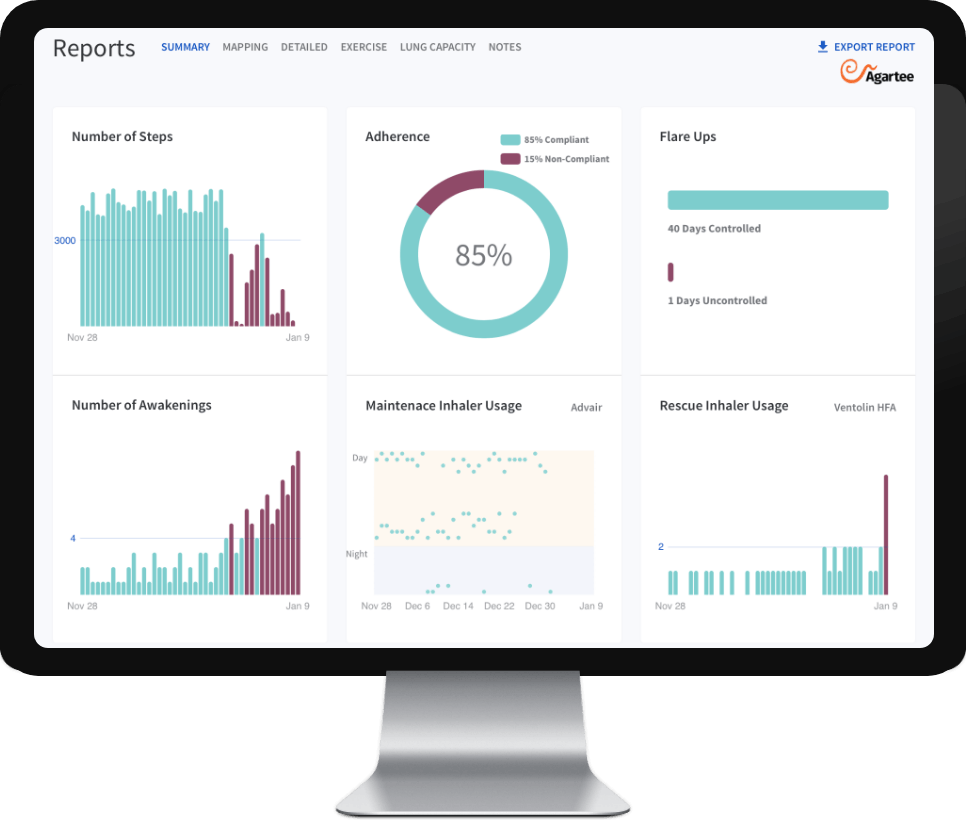Tackle low medication adherence in chronic diseases
Use behavioral analysis to design better human-centered drugs and increase revenue while improving patient outcomes

$2.6 billion is spent developing a new drug, but more than 30% of patients never fill their prescriptions and 50% of patients with chronic diseases do not take their medications correctly. 1
Non-adherence is particularly high in pulmonary diseases, as 50% of children with asthma or seniors with COPD do not use their medication. 2
Our Solution
Our Solution
We provide behavioral analysis and reports on why patients with chronic diseases do not adhere to their medication plan.


Improve adherence, increase your revenue
Improve adherence, increase your revenue

Build confidence among payers and provide more transparency
Build confidence among payers and provide more transparency

Accelerate your time to market by home-based digital clinical trials
Accelerate your time to market by home-based digital clinical trials

A 10% increase in medication adherence improves patient outcomes and can mean $124 billion in revenue for pharmaceuticals. 3
Case Study
3min read
Pharmaceuticals use AI-based behavioral analysis to improve adherence to drug usage

The Situation
A pharmaceutical manufacturing the Metered Dose Inhalers (MDI) was facing a 50% attrition rate. MDIs are used to treat or manage chronic pulmonary diseases such as asthma or Chronic Obstructive Pulmonary Disease (COPD). The company wanted to conduct a home-based clinical trial and human factors testing but the trials were very costly and taking years. A more effective, accurate, and economical method was needed to integrate the usability modifications and improve patient behaviors.
The Challenge
Non-adherence is mostly caused because patients either cannot easily use the drug or they do not see the benefit. Therefore, many behavioral questions should be answered to find out the reasons. Did the patients forget how to use their inhaler? Did the adverse effect of inhaled medication during sleep cause them to stay awake all night? Did the patients understand when they should use their inhaler and how many times?
Confrontation with the patient is not an effective method to tackle non-adherence issues. Care teams and drug developers should ensure the patient perceives the treatment to be effective and prefers to use the drug as a necessary part of the care plan, then understand the dosage and when to take the drug.
The Solution
To provide insights on important KPIs such as adherence rate, preference rate, and effectiveness rate, the following program was created:
- 1. Developed a program to monitor inhaled medication usage, activity, and sleep
- 2. A report on the behavioral changes and correlations among various biometrics
The new insights sparked effective interventions and preventative measures, leading to an increase in the effectiveness of the treatment of pulmonary disease. Therefore, patients adhered more to their medications. The better behavioral data prompted real behavioral changes that led to better outcomes.
We've heard things like ...
We've heard things like ...
Find out how your organization could benefit with Agartee
Find out how your organization could benefit with Agartee
1. Interventions to improve adherence to self-administered medications for chronic diseases https://www.ncbi.nlm.nih.gov/pubmed/22964778
2. Pragmatic trial of health care technologies to improve adherence to pediatric asthma treatment https://www.ncbi.nlm.nih.gov/pubmed/25664620
3. Estimated Annual Pharmaceutical Revenue Loss Due to Medication Non-Adherence https://www.capgemini.com/wp-content/uploads/2017/07/Estimated_Annual_Pharmaceutical_Revenue_Loss_Due_to_Medication_Non-Adherence.pdf



